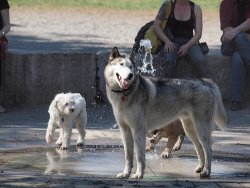Excessive Grooming in Cats
In many cases, our pets develop issues that need special attention and there may be signs of potential problems. One of these issues is apparent when you observe excessive grooming in cats.

Beluga
Cats must groom themselves. It’s a natural part of their behavior. However, under some conditions, cats can groom themselves excessively. While you may not think this is a serious issue, it can be. If you notice excessive grooming in your cat, pay attention. They will vomit hairballs more often. In any case, try not to let it go on too long. The cat can end up with bald or red spots in certain areas of her skin, or an open sore.
Excessive grooming in cats can be linked to a lack of attention, boredom, insufficient grooming by the owner, and even separation anxiety. Many of us have a misconception that cats don’t need attention because they are aloof, independent, and free-spirited. That’s not the case. They may not be as needy as dogs but that doesn’t mean they don’t need attention and affection regularly.
If you notice your cat grooming too much, try distracting him or her, play a little bit. If the behavior then stops, you can attribute it to boredom and then you might help by providing more distractions. However, if the cat goes back to grooming right away take him or her to the vet as soon as possible. The vet can rule out parasites or a fungal infection. Your cat may be having an allergic reaction or could be suffering from an autoimmune problem. He or she can help treat the medical problems and can also assist you in stopping the behavior to prevent future medical issues. The vet might prescribe antihistamines, herbal calming remedies, and antianxiety medications that can help break the cycle and calm your cat.
While knowing what caused the behavior is not always necessary for effective treatment, it may help you to understand what brought about your cat’s obsession with excessive grooming. Changes in the environment and the resulting stress can sometimes be a cause. For example, if you have just added a new member to the family – feline, canine, or even human.
You won’t be able to tell from the behavior itself whether the cause is psychological or physical, but excessive grooming should definitely be discussed with your vet, especially if it accompanies other changes in your cat’s behavior, such as reduced energy levels.
The bottom line is that you should talk to your vet if your cat’s behavior disturbs you in anyway. Observe your cat and groom him or her yourself regularly. Being aware of any changes in your cats behavior can avoid difficult medical problems down the line.
Socializing Your Puppy or Dog
When you have a child, you have a responsibility to introduce him or her to a wide range of people and experiences to better prepare them for the world. The same is true when you have a puppy or a dog. This process is known as socialization. Let’s look at some of the reasons why this process is so important and how you can be sure to properly socialize your canine companion.
Good Reasons to Socialize
If you’ve seen aggressive dogs before, you’ve also seen the consequences of poor socialization. When dogs haven’t been introduced to these new experiences, they become fearful and anxious when encountering them. Just think of how you felt on the very first day you ever worked at a job or the first day you went to school.
Socialization, therefore, helps make dogs more comfortable when they have these experiences, such as meeting a new dog at the pet store or being petted by children or riding in the car. Positive early experiences are the best way to prevent future anxiety and aggression problems in your dog.
Another good thing about socialization is it helps you meet new people and have new experiences. Taking your dog to the park, for example, is a great way to start up conversations with people if you are normally a shy person.
Methods of Socialization
Obviously, the best time to start is when the puppy is very young. Take him or her with you whenever you can, and let people approach and pet him. Take him to the puppy education classes of your local pet shop where he will interact with other puppies. Take him to the small dog area of your local dog park. See how he reacts, how he acts, and get to know him well.
If you adopted an adult dog, hopefully he will have been exposed to other people and dogs in positive situations, but you still have to see for yourself how he reacts around people and animals.

The most important part of the socialization process is the positive experience. If you take your dog to the dog park for the first time and the experience is horrible, she is going to be more reluctant to return the second time. She may be fearful or anxious which could lead to another bad experience. Before you know it, the dog park is off limits. You obviously don’t want that to happen.
So, take her at a time when there are not a lot of dogs around. Don’t bring her in with the leash on. By now you should know how she reacts to other dogs she might have encountered on her walks. If she tends to be aggressive, you might need to do some training before exposing her to a large dog park. How can you guarantee a positive experience? Remove your own fear and nervousness about the situation. If you’re nervous, your dog will be, too. Always be positive and assume that the experience is going to go well.
Another way to do it is taking him to the pet shop, where she or he will probably encounter other dogs. When you go to the pet store, keep your dog on leash at all times (and do not use extensible leashes) and pay attention to his or her behavior. A dog that starts acting nervous or becomes very alert needs to be corrected immediately.
If your dog becomes nervous under certain circumstances, it’s a good idea to calmly make him or her confront what is causing the nervousness… unless it is a real threat. If you’re walking your dog on the sidewalk and a city bus drives by and startles your dog, the next time a bus comes, make him sit instead of letting him hide from it. Have him sit until the bus passes and then praise him like crazy. Now, if an unleashed, threatening dog were approaching you, this would require a different tactic and would not be the best time to confront the problem.
The important thing is to have your dog encounter as many new experiences and people as possible. Walk him or her in different locations: your neighborhood, the park, the river, around shopping areas that permit dogs, near roads, around noisy areas, and around quiet areas. You also want your dog to interact with other animals and people, including people of all types and ages. Make sure your dog is also socialized to lots of experiences, including riding in the car, having his feet touched, being groomed, getting a bath, being petted, and more.
The bottom line is that thorough socialization does take time and commitment from you, but the results are well worth the effort.
The Awful Reality of Puppy Mills
You’ve probably heard about puppy mills. But did you know that if you purchase a dog from a pet store and many of the breeders online or in the newspaper, you could be helping keep the puppy mill industry afloat?
Most people don’t realize where those dogs who suffer so much end up. They often don’t even know how much suffering the dogs have to endure. Below is some information you should read before you decide how to find your new canine companion.
The Abuses of Puppy Mills
If you’re not familiar with the term “puppy mill”, you may want to learn about them before you start looking around for your new puppy or dog. Basically, puppy mills operate like factories to produce new offspring that can be sold.
Female dogs are bred from their first heat cycle and again each time until they are no long able to reproduce. Then they are “disposed of.” The puppies are kept with their mothers in tiny cages, usually stacked on top of one another in cramped and dirty environments. Because the cages are made from wire, the excrement and urine from the above dogs can fall down onto the lower dogs. The wire cages also cause foot injuries and are very uncomfortable.

A Living Hell
Most of the dogs are underfed. Most have worms because of their close quarters and their unhygienic environment. Fleas and mites are huge problems because most of these puppy mills are located in the country and none of them receive any type of preventative care. Some even contract heart worms and other serious illnesses. They also tend to have emotional problems because they lack any human contact during their formative years, and because their mothers are usually too weak to give them much compassion.
In some of the worst of these places, dead dogs are left in the cages to decompose with the living ones.
Where the Puppies Go
As you can imagine, most “hell operators”, as I like to call them, do not sell their “stock” from their factory. Instead, they have other ways of connecting with potential customers. Pet shops are one of the largest buyers. Most of the dogs you see being sold in pet stores for hundreds of dollars were bought for a fraction of that from puppy mills. However, since the puppy mills sell hundreds of dogs every couple of months, they are profiting from these sales in major ways.
But pet stores are only one method. Many of the breeders who advertise online and in the newspaper are also puppy mills themselves or are selling supplies of dogs they have gotten from puppy mills.
What you get is a puppy facing an array of immediate medical problems and with genetic diseases that will surface years later.
Signs of a Puppy Mill
Regardless of what pet stores may say, their supply of dogs comes from puppy mills. However, with breeders, you may have a harder time recognizing the possibilities. To protect yourself, always ask to visit the puppies on-site so you can view the condition of the mother and possibly the father. For obvious reasons, if you are buying directly from a puppy mill, they will have some excuse as to why you cannot do this.
If you do arrive on-site but are not allowed to see the mother of the puppies, this is also a sign the puppies may be from a puppy mill and that the mother may be another location altogether.
Never buy a puppy without seeing where they and their parents are raised and housed with your own eyes. Do your research; get references about breeders in your area.
While your heart may go out to these suffering puppies, when you buy them from these sources you’re only contributing to the problem and continuing the puppy mill business. That’s why I always urge and encourage people to adopt either from a humane society, a rescue, or a shelter, and help put those torture chambers out of business for good.
Good Reasons to Keep Your Cat Indoors
For many cat owners, the choice of whether to keep their cat indoors or to let it roam free at least part of the time is difficult. Some cat lovers believe keeping your cat cooped up indoors all of the time amounts to cruelty. Other cat lovers argue that the dangers of allowing domesticated cats to run in the streets far outweighs any potential benefits for the cat. From the title of this piece, you can probably guess which side of the issue I’m going to side with. But I think it’s important for people to realize how dangerous things can be for cats on the streets.
The Disease Factor
Cats that spend even part of the time outside are at a significantly higher risk of catching one of the common feline diseases than those who live indoors. And don’t assume your cat is not at risk because he or she has been vaccinated. According to the Community Animal Welfare Society, most vaccines only provide up to 85% protection against these diseases so your cat is still a risk of becoming gravely ill.
Feline Leukemia is one of the most common diseases in cats and is transmitted through cat saliva, which means a stray cat that licks your roaming pet or a water source used by multiple cats can be a source of the disease. A second serious disease is Feline Immunodeficiency Virus (FIV). This disease is transmitted through cat blood so if your pet becomes involved in a fight with another cat while roaming outdoors he could contract the disease. Unfortunately, FIV is fatal and no cure is available at this time.
The Human Element
While cats do run a serious risk of catching disease from other felines outdoors, that’s not the only risk they face. Not everyone in your community is going to appreciate the activity of these free-roaming cats. A neighbor fed up with the cat’s visits to their yard, might deliberately leave out poisoned cat food or other dangerous things for cats. In other cases, toxic chemicals, such as those in antifreeze, are located in places where cats like to end up and can result in their death.
Humans can also be cruel. Around Halloween every year, hundreds of black cats are killed around the country in pranks. Cats that roam the streets are a very likely target for this type of behavior, especially since most owners let them out for the night when pranksters are most often on the prowl. They can also be caught and sold to research facilities, or taken to a shelter, where they will be euthanized in as little as 2 days if you don’t know he is lost.
Other Risks
Besides disease and human cruelty, roaming cats have other reasons to be afraid. They are an easy victim for dogs and other predators, and traffic. Who knows how many pets can be found flattened on the pavement every night. Cats can also be killed by cars in other ways since they like to sleep under them.

Build a Nice Outside Area
Cats that run in the neighborhood are also much more likely to contribute to the out-of-control cat population. Unless you have spayed or neutered your free roaming feline, you are undoubtedly adding to the problem. Too many cats are already euthanized daily because they do not have a proper home.
In some cases, very cruel owners will have their cats de-clawed but still allow them to roam the streets at night. This leaves the cat defenseless in the face of an attack. Not only can the cat not fight back against predators or other cats, but he or she cannot even scale a tree or a fence for protection from the attackers or from other threats.
The bottom line is that letting your cat outside provides no real benefits – only very real risks – to your cat’s health and safety. Don’t do it.
If you feel your cat is missing out, provide him with a good cat condo, if you lack the space you can always buy cheap Ikea shelves, glue on pieces of carpet that you can get as scrap at carpet places, and put them on the wall so your cat can climb up on the wall. They even look cool!
Give him or her a nice window seat to look out.
Teach them to walk on a leash. Yes they can be trained. They will initially feel confined by the harness, and their first attempts at walking on a leash might look uncomfortable and a waste of time, but with love and patience on your part, most cats will enjoy leash walking.
Build them an outdoor condo where they can come out and enjoy the sunshine if you have the space. You don’t have to spend a fortune.
Get them a mesh front carrier. Most are for dogs, but they can be used for cats as well. You can take them with you and go for walks, or get them a kitty stroller. You can get them at good prices online.
The point is, you can keep them safe and satisfied, and exercised, and they will never miss the great outdoors.
The Benefits of Using a Dog Park
Dogs of all ages need exercise. Nothing can replace a good walk with a human companion, but all dogs really want a chance to run and really stretch their legs. If they can enjoy the camaraderie of other canines at the same time, that’s even better. And that’s why dog parks are such a great place for your pets.
Let’s look at some of the good reasons to use your local dog park, as well as a few precautions you should be taking, too.
Socialization Galore
If you’re fortunate enough to have a popular dog park in your community, this can be a great source of socialization for your dog. Dogs need to have as many interactions as possible with other dogs and with humans so they will feel comfortable in lots of different situations. A well-socialized dog is less likely to be anxious, nervous, or aggressive. Because a dog park is full of people and pets, socialization is almost guaranteed.
Fun for Dogs of All Types
Dogs love to walk and explore their environment, but they may not always like having to be leashed in the process. Even if you have a big fenced in yard where your dog can run safely unleashed, if he or she doesn’t have a buddy to chase around the fun may be limited. At the dog park, dogs can do their own thing off-leash. Older dogs might just want to find a shady spot under a tree. Active dogs may want to play as a pack. Some dogs may want to play fetch with their human companions.
If you’ve never seen the pure look of happiness on the face of a dog running off-leash, you need to head to the nearest dog park and see it for yourself.
Healthy Exercise
Another benefit is the exercise for your dog. Dogs who don’t get enough exercise are prone to obesity, arthritis, and other serious health problems. Plus, they are more difficult to live with because all of the pent up energy is going to emerge as destructive, unwanted behavior in your home.
While walking your dog is good exercise for both of you, the dog park is going to give your dog a chance to really get a workout and drain that energy. Regular visits to the dog park will make a huge difference in even the feistiest dog.

A Few Precautions
Dog parks clearly have a lot of benefits, but you do need to take some precautions for your pet’s protection and your own.
1. Separate Small and Large Dogs – Most dog parks have separate areas so small dogs can enjoy themselves safely. Large dogs, even the friendly ones, can accidentally injure a small dog. Obey the rules on separation by size, and if your particular park does not offer that option, start campaigning in order to have the city establish it.
2. Look Around – Always keep an eye out for dog fights, which will undoubtedly happen once in a while. If you know the park well, be aware of new dogs coming into the park and their general demeanor.
3. Keep Your Dog Under Vocal Control – Even though the dog park is a place where humans can mingle, too, you don’t want to become so distracted in your conversation that you can’t pay attention to what your dog is doing. Most dog parks do have rules requiring you to have vocal control over your dog at all times.
4. Keep Your Eyes Open – The dog park will give you a chance to socialize with other dog owners, however, always keep your dog in sight. Be aware of other dogs getting aggressive, or even of what he get’s into his mouth. One of the ways to keep the parks pleasant, is for the owners to always pick up after their dogs. Don’t be so distracted that you don’t see when your dog does its business.
5. Bring Water – Although some dog parks do have the ability to provide water for the dogs through a fountain, most do not. Always bring along water for your dogs because the can easily get overheated when they’re playing in the warm sunshine. In the summer, you might find the best times to play are in the morning and in the evening before sunset.
6. Protect Yourself – Getting to know your fellow dog lovers is a great idea but you have to be careful. Just because someone owns a dog that doesn’t mean they are a wonderful person. Be careful about how much personal information you reveal about yourself. Do not leave your purse or wallet visible in the car while you are inside the park. Would be thief knows you’ll be distracted and will take advantage of the fact.
Most importantly, use this play time to bond with your dog. Don’t just get there and ignore him or her the rest of the time. Nothing will make your dog happier, than having the chance to play with you.
Bringing a Kitten Home
Chances are your entire family is going to be excited about bringing a kitten home. Or maybe your are bringing a grown cat to your family. But you’ve got to remember your new feline addition doesn’t know to be excited. He or she just knows to be nervous. That’s why you want to make the transition as calm and smooth for your new pet as possible. For starters, try to remain calm when bringing a kitten home. If you have children, discourage them from chasing, holding, or trying to give the cat a lot of affection for the first few days. Let the cat get settled first.
You should also remember that cats are extremely curious. Because cats should be kept indoors for their health and safety, you want to make sure there are no escape routes to the outdoors your cat might find while snooping around its new environment. Keep in mind that cats can make themselves pretty small if necessary to sneak out so don’t take any chances. Posting notes on all of the doors to remind family members and guests to watch out for a potentially escaping kitten is also a smart idea.
Because your cat is going to need to feel comfortable riding in the car when you take him or her home, invest in a pet carrier and add some blankets, toys, or anything that smells like the cat’s previous living quarters. This is going to make her more comfortable. Always have your cat in the carrier while traveling by car. She will feel safer than if you let her roam freely around the car. Plus, a curious cat could cause you to have an accident.
For the first few days, you’ve got to resist that urge to cuddle and love your new kitten. She needs to feel safe and comfortable before you overwhelm her with your affection. And cats tend to be a lot more cautious than dogs.

Matilda
When you first arrive home, take the carrier to a room in your home. It’s a good idea to use your own bedroom so the cat can become comfortable with the adults in the home first. Plus, children have a hard time resisting the impulse to hug the kitten. Inside the room, place the carrier on the floor and open the door. Have the cat’s food, water, and litter box inside the room as well. You want to confine the cat to this small space before opening up the entire house to her. Remember not to pressure or coax her to come out. When she feels comfortable, she will emerge from the carrier and begin a thorough investigation of the area.
Try to minimize the cat’s contact with your children or other pets for a few days. Then you can begin slowly introducing them. Make sure that your kids stay calm around the cat and talk in a quiet voice as to not startle her. As far as the introduction to the other animals, this should be done slowly and always in a very controlled way. You want to make sure they are going to get along well before you allow them to have complete access to one another.
When you are expanding your kitten’s access to the rest of the house, make sure to carefully kitten-proof it. That means eliminate anything that might look like a toy, including window blind cords and electrical wires. If there are any places you do not want your cat to go, spray them with a lemon-scented liquid. Give your kitten some safe toys to keep her occupied and out of trouble.
Now, you are ready to fully enjoy bringing a kitten home and having it as a new family member.
Feng Shui and Your Pets
I’m sure you’ve heard of it, unless you’ve been in Mars for the past couple of decades, but I’d like to give you my own description of Feng Shui.
Feng Shui is the ancient practice utilized by the Chinese to assist in harmonizing everything that surrounds you. The idea is that as long as everything around you is harmonious, your own energy and the cosmic energy, or Ch’i will help you increase your happiness, your health, your wealth, your family life, your relationships etc. Feng Shui teaches us how to place our furniture, our decorations, and how to use our colors and textures to achieve the greatest benefits possible in each area of your life.
Many people see Feng Shui as a superstition, and I tell them they couldn’t be more wrong. Although Feng Shui gives you “cures” for the problematic areas of your house, office, apartment, etc., their purpose is mostly to add an element that a certain area might be missing. Feng Shui teaches us the best way to achieve harmony.
Feng Shui uses a lot of common sense. If you walk into your house or apartment and you see clothes lying around, dirty dishes in the kitchen, a burnt out bulb in the entrance, a TV that doesn’t work in your den… what do you feel? I’d bet you start feeling stressed thinking how you haven’t had time to clean the place, how you have to find the time to change the bulb, how you have to wash the dishes or fix the TV. That’s energy that just drained from you. But, if you come in and you are welcomed by a clean and organized place, and you see harmonious colors, and smell nice aromas, your stress level will drop considerably. Don’t you feel just great when you’ve finally get that faucet fixed? Doesn’t it take a weight off your shoulders when you finally organize your drawers?
Sometimes all it takes is adding a light to a dark corner, or a splash of color in the room or a plant in front of the window to make the place come alive.
Have you ever been in someone’s home and you just feel so comfortable you don’t want to leave?
On the flip side, there’s places that you just can’t wait to get out of!
Well, pets are particularly sensitive to the energies around our home and surrounding environment. Animals have the ability to sense things that humans don’t. Observe your pet, they can give you an idea of how Ch’i is working in your home.
Almost all cats and dogs know what room and what area of the room they do best in. Their health and their character reflect the energy of the house and the people living in it. When pets are ill, lethargic, or maybe even overweight, chances are that people in your household have the same symptoms. If your animals are happy, well adjusted and lively, that will be the general feeling in your life.
Simply getting a pet if you don’t already have one is a good way to enhance your Ch’i. Animals represent fire energy. Adding fire energy to your life will make you more passionate and will give you motivation to do the things you like. They can help with depression, loneliness or bring a welcome change if you’re in a rut. They just make life better.
Now, you also have to think about giving them a harmonious life as well. Get down to their height. Look around. What would you see if you were a small animal. Make sure that there’s no mess under the bed, which, by the way, would be bad Feng Shui for you as well. Look at the corners of the floor. Do you see dust bunnies or accumulated dirt? Look under the sofas. Under the coffee table. Notice that whatever you do for them, will also be good for you.
Give them a place of their own. A bed, their water bowl, their toys…. make it nice.
When you don’t feed, bathe and nurture your pet properly, your Feng Shui will suffer. Even if you don’t realize it, the way you treat people, pets and plants is very important for your own self-image and well being.
Animals are the best way to experience good Feng Shui. Find out the pros and cons of getting a new pet and adopt a friend from your animal shelter. You won’t regret it and your life will definitely be better.
Top Ten Friendliest Cats
I think all cat owners have made this mistake: they go to the shelter or rescue and choose the cutest cat in the bunch, without even considering its temperament or personality. Then it turns out the cat ends up not being what they expected. Some are timid, some like to be petted and others don’t, others love to play, while others will hide under the bed all day. What are the friendliest cats? When you go to the shelter or rescue, always ask the people in charge what breeds the cats they have there resemble the most. They will almost always tell you, “This one has a little Ragdoll in it, this other has a bit of Maine Coon”, and many times you will find pure breeds that have been abandoned… so keep this list of the top ten friendliest cat breeds before you go to find the most wonderful treasure you will ever have.
Click on each picture to see their wonderful qualities:
(See below for a list of picture credits)
 #10 Chantilly-Tiffany |
 #9 Somali |
 #8 Ragdoll |
 #7 Persian |
 #6 Manx |
 #5 Maine Coon |

#4
Burmese |
 #3 Birman |
 #2 Exotic Short Hair |
 #1 Abyssinian |
CLICK HERE TO SEE THE FRIENDLIEST DOGS…
Photo Credits:
Persian Cat
Top 12 Friendliest Dogs
When you decide to bring a new dog into your life, it helps to know its temperament, what’s the breed’s normal behavior, what are its characteristics, etc. Some dogs are great for kids, when some others are better suited for athletic grown ups, and yet others are better with elderly people. But, which breeds make the friendliest dogs? Some breeds are friendlier by nature than others, that’s not to say that a dog’s temperament cannot be greatly dependent on the owner’s behavior and lifestyle. It also doesn’t mean that if the breed tends to be friendly, it’s automatically an appropriate breed for all people. To help you do your homework, here’s a list of the top 12 friendliest dogs around.
Click on the pictures to learn more!
 #12 #12Brittany Spaniel |
 #11 #11Japanese Chin |
||||||||
 #10 #10Vizla |
 #9 #9Springer Spaniel |
||||||||
 #8 #8Cavalier King Charles |
 #7 #7Papillon |
||||||||
|
|||||||||
CLICK HERE TO SEE THE FRIENDLIEST CATS…
Photo credits:
Bringing Your New Dog Home
So you’ve taken the plunge and adopted a dog of your own.
Congratulations! But what do you do now? No doubt you’re excited and looking forward to forging a lifelong friendship with your new buddy. But try to keep in mind the confusion he is feeling right now. Whatever his past history, coming home with you is a new experience. He is likely to be a little disoriented, wondering where he is and who all these new people are.
The key to helping your new dog make a successful adjustment to your home is being prepared and being patient. It can take anywhere from two days to two months for you and your pet to adjust to each other.
The following tips can help ensure a smooth transition:
Supplies
Prepare the things your dog will need in advance. You’ll need a collar and leash, food and water bowls, food, and, of course, some toys. And don’t forget to order an identification tag right away.
Welcome Home
Try to arrange the arrival of your new dog for a weekend or when you can be home for a few days. Get to know each other and spend some quality time together. Don’t forget the jealousy factor—make sure you don’t neglect other pets and people in your household!
Health Care
Animal shelters take in animals with widely varying backgrounds, some of whom have not been previously vaccinated. Inevitably, despite the best efforts of shelter workers, viruses can be spread and may occasionally go home with adopted animals. If you already have dogs or cats at home, make sure they are up-to-date on their shots and in good general health before introducing your new pet dog.
Take your new dog to the veterinarian within a week after adoption. There, he will receive a health check and any needed vaccinations. If your dog has not been spayed or neutered, make that appointment! There are already far too many homeless puppies and dogs; don’t let your new pet add to the problem. Most likely, the shelter will require that you have your pet spayed or neutered anyway. If you need more information about why it is so important to spay or neuter your dog, read our online information on spaying and neutering.
House Rules
Work out your dog-care regimen in advance among the human members of your household. Who will walk the dog first thing in the morning? Who will feed him at night? Will Fido be allowed on the couch, or won’t he? Where will he rest at night? Are there any rooms in the house that are off-limits?
Training and Discipline
Dogs need order. Remember, they are pack animals, so make yourself the “pack leader.” Let your pet know from the start who is the boss. When you catch him doing something he shouldn’t, don’t lose your cool. Stay calm, and let him know immediately, in a loud and disapproving voice, that he has misbehaved. Reward him with praise when he does well, too! Sign up for a local dog obedience class, and you’ll learn what a joy it is to have a well-trained dog.
Housetraining
Assume your new dog is not housetrained, and work from there. Read over the housetraining information given to you at the time of adoption. Be consistent, and maintain a rou tine. A little extra effort on your part to come home straight from work each day will pay off in easier, faster housetraining.
Crating
A crate may look to you like the canine equivalent of a jail cell, but to your dog, who instinctively likes to den, it’s a room of his own. It makes housetraining and obedience-training easier and saves your dog from the headache of being yelled at unnecessarily for problem behavior. Of course, you won’t want to crate your dog all day or all night, or he will consider it a jail cell. Just a few, regular hours a day (but no more than four hours at a time) should be sufficient. The crate should not contain wire where his collar or paws can get caught, and should be roomy enough to allow your dog to stand up, turn around, and sit comfortably in normal posture.
If you still can’t face the idea of a crate, at the very least consider some sort of confinement to a dog-proofed part of your home. A portion of the kitchen or family room can serve the purpose very well. (A baby gate works perfectly.)
Let the Games Begin
Dogs need an active life. That means you should plan plenty of exercise and game time for your pet. Enjoy jogging or Frisbee? You can bet your dog will, too. If running around the park is too energetic for your taste, try throwing a ball or a stick, or just going for a long walk together. When you take a drive in the country or visit family and friends, bring your dog and a leash along.
A Friend for Life
Finally, be reasonable in your expectations. Life with you is a different experience for your new companion, so give him time to adjust. You’ll soon find out that you’ve made a friend for life. No one will ever greet you with as much enthusiasm or provide you with as much unqualified love and loyalty as your dog will. Be patient, and you will be amply rewarded.
Reprinted by permission of
The Humane Society of the United States.




 #6
#6 #5
#5

 #2
#2 #1
#1